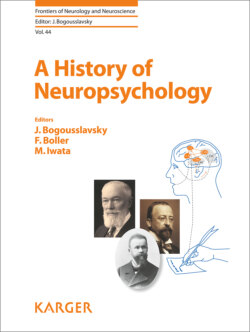Читать книгу A History of Neuropsychology - Группа авторов - Страница 15
На сайте Литреса книга снята с продажи.
Speech and the Frontal Lobe
ОглавлениеLeborgne was a 51-year-old patient at the Bicêtre, a hospital on the outskirts of Paris, where Broca was on staff. He had been epileptic since his youth, and in 1850, following a series of strokes, became paralyzed on the right side, losing his ability to speak. In the hospital, he became known as “Tan” because, with one exception to be noted later, it was the only articulate sound he could make. Broca called the condition aphemia; the term we have come to use, aphasia, was Armand Trousseau’s [14] (see Ryalls [">15]). In 1861, when gangrene set in, Leborgne was treated by Broca but died soon after. Upon examining his brain, Broca found softening throughout the left frontal lobe apparently centered around F3, the posterior part of the third, or inferior, frontal convolution.
Broca’s three reports [16-18] on Leborgne and a second speechless patient, Lezare Lelong, focused on the frontal location, but as evidence mounted, so did his appreciation for the “remarkable fact” ([19], p 202) that the damage was always on the left. By 1863, he had ten such cases, and, finally, in 1865 [20], with still more, he famously declared, “we speak with the left hemisphere” (“nous parlons avec l’hémisphère gauche”), with F3 at the center (p 384).
More evidence soon came in support, either of speech loss after left-anterior injury or no loss after injury on the right. But as Broca [21] knew, “in pathology and especially in cerebral pathology, there is hardly any rule without exception” (p 385), and here the most challenging were reports of persons who became aphasic after injury to F3 on the right. Broca [20] acknowledged “the existence of a small number [petit nombre]” who “speak with the right hemisphere” (pp 385–386) and analogized them to another exceptional group, left-handers. Many assumed he meant it was left-handers who “speak with the right,” but Broca rejected any necessary “coincidence” between the groups (p 387). Among other reasons, the numbers did not match, and Broca cited reports estimating the incidence of left-handedness at 1 in 10 but only 1 in 20 for right-hemisphere speech. The evidence for lateralization converted most but not all believers in the law of symmetry. Bastian [22], for one, said it was “only fair” to suppose that the hemispheres “should be endowed with like functions,” since they, like the sense organs, “may be said to have a bilateral symmetry.” He therefore was “strongly inclined still to believe in (their) similarity of function, … notwithstanding all that has been said of late in opposition to this doctrine” (p 455). In years past, the doctrine may have dissuaded some, like Bouillaud [7], from even looking for differences. There were 29 patients in his report linking aphasia to anterior-lobe lesions. From the list, Benton [23] determined that 25 had unilateral lesions, 11 left, 14 right, and that 8 (73%) of the former were aphasic, only 4 (25%) of the latter.
If Bouillaud fell victim to conventional wisdom, it was only in the sense that he failed to compare his left- and right-side cases or chose not to mention the difference. Marc Dax, in a paper written in 1836, actually proposed that the left hemisphere was the speech side after observing that aphasic patients more often have right than left hemiplegia. Dax prepared his paper for a medical society meeting but, evidently, never delivered it, and it remained unknown and unheralded until his son, Gustave, published it in 1865, along with his own report on the same subject ([24, 25]; for reviews, see Finger and Roe [26]; Joynt and Benton [27]).
